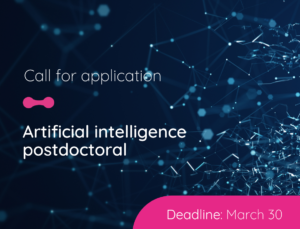
Gonzalo Bustos, one of the researchers at the National Center for Artificial Intelligence (Cenia), explains that the system will allow integrated monitoring and automated diagnosis of crop conditions.
Researchers at the National Center for Artificial Intelligence (Cenia) are developing a project to use artificial intelligence (AI) in phytosanitary control and integrated crop management. This project is in an exploratory stage and funding sources are being sought. Its objective is to rationalize the use of fertilizers and agrochemicals in the local ecosystem, which, when applied indiscriminately, end up affecting the fields and agricultural workers. Gonzalo Bustos, a Cenia expert, explains that the system will allow a more precise diagnosis of crop conditions in order to apply control measures only when and where they are required.
Agriculture is the second largest contributor to greenhouse gas emissions, largely due to nitrogen fertilizers and other agrochemicals derived from fossil fuels.
As the researchers explain, this problem has already been understood in the large-scale agricultural sector in international markets, where for massive soybean and corn crops, among others, “numerous companies and institutions have promoted the use of AI and robotics for a more focused and sustainable management, decreasing the use of agrochemicals by up to 90%, in addition to reducing the use of water while maintaining productivity per hectare.”
This type of technology is already being used internationally, in large markets such as the United States, Europe, Brazil and Argentina, but in Chile we need solutions that are appropriate for our farms and the size of our agricultural operations.
Diagnosis
Scientists are developing a data acquisition and processing system based on a network of agricultural sensors and images from multispectral and thermal cameras. With this technology, it is possible to see characteristics that are not visible to the human eye, allowing early detection of unfavorable conditions (lack of water or nutrients) and the appearance of pests and diseases. In addition, there is a monitoring and management platform based on artificial intelligence models, using the data collected and other sources of information such as weather stations and satellite images, and a prototype of an agricultural robotic assistant for phytosanitary control in productive environments.
According to Bustos, there is little sensorization and analysis capacity in agricultural fields, so the plan is to install them on farms to monitor crops, such as wheat, rice, fruit or vegetables. Chile’s institute for agricultural research (Instituto de Investigaciones Agropecuarias, INIA) is helping them, through an experimental field they own in the Ñuble region, in Chillán.
Once the sensors are installed, the idea is to extract the data, monitor them and understand the state of the crop: to know if it is well, if it has any pests, insects or weeds that are attacking it, its level of growth or nutrients, if it is stressed, or in a good type of soil, with the necessary humidity. “This stage corresponds to phytosanitary monitoring and the detection of abnormal conditions where it lives,” says Bustos.
Out of place
Weeds are plants that affect the growth of other plants. For example, if there is a wheat field and a corn plant appears, it is already considered out of place, since it takes away nutrients, water and light. The main problem is that this crop can be lost. Lorenzo León Gutiérrez, agronomist and researcher at INIA, points out that, annually, these weeds mean billions of dollars in losses for global agriculture.
The expert explains that in Chilean crops, on which we depend for food (such as rice, wheat or legumes), the pressure of weeds is very high, which increases the amount of agrochemicals needed to control them. “That is why from INIA, together with Cenia, we are working to reduce the usage rates of these products, and only how much it is required and where it is required with the use of technology that is, at the same time, affordable for farmers,” he says.
Action and management
Early identification of potential problems in a crop can help to manage them appropriately. Thus, for example, in the case of weeds, there are several options for its handling, according to the researcher. One of them corresponds to mechanical control, where the person in charge controls the weeds with weeding tools, or if the field is very large, with machinery that can even be automated. There is also the so-called “culture control”, a strategy that consists of providing the best conditions for the crop to grow rapidly, thus defending itself against weeds.
Another method of phytosanitary control is through pesticides, but they can be a big problem if used indiscriminately. “Chile has a higher level of use than the world average. That is why there are initiatives to reduce it, since when it is applied it contaminates the whole countryside (reaching groundwater, rivers, etc.),” explains Bustos. And he adds that people are the most affected. An article in the scientific journal, BMC Public Health (2020), estimates that 385 million cases of pesticide poisoning occur globally every year, with 11,000 deaths.
However, by not using them, harmful agents (insects, worms, for example) can proliferate and affect cultivated areas. On average, on a global scale, between 10% and 28% of crop production is lost due to pests, according to the United Nations Food and Agriculture Organization (FAO).
“There we are faced with the fact that we want to avoid the use of pesticides because of the damage to people’s health and the environment, but, on the other hand, we have to look for strategies to prevent the loss of such a high level of agricultural production,” he says. In Chile alone, according to FAO, 700,000 people suffer from severe food insecurity. For this reason, the project proposes the use of technology that allows early detection of pests and diseases and much more precise application of these products.
“Some international experiences have shown that similar tactics can reduce the use of pesticides by up to 90%, because they are only applied to the area where the disease or the critical health situation of the crop is,” says Bustos. Such an initiative could help growers become more efficient with the use of resources. The use of pesticides or fertilizers is one of the highest costs in the production chain.
Data processing
The solution proposed by Cenia’s researchers seeks to integrate different sources of information with processing models, something that, according to the researchers, is not available in the market. There are products to identify crops, weeds and types of insects, based on photographs and AI, but none are applied in an integrated manner at the local level.
“We are thinking of a hybrid solution, that is, taking models that already exist, but integrating them into a single, centralized platform, which can be used by a group of agricultural producers for monitoring, control and management of crops in a more efficient way,” says Bustos.
Such a platform would be able to deliver performance indicators, health status and also provide recommendations. And unlike similar models used abroad, this one will be adapted to local conditions. “Our crops are very particular and existing solutions are not necessarily replicable. We have a wide variety of soils, climates and crops that we need to consider in our solutions,” explains Bustos.
Guidelines
The innovation seeks to integrate with the production sector, in order to know how field conditions are evolving and to establish guidelines or recommendations for action. In this way, scientists and workers could know how to help an infected plant to overcome the situation in the best way possible. “For that you need agricultural models, that help you understand the behavior of a crop in different conditions, whether it’s water, temperature, etc. And with the model we developed we can help them make decisions,” he says.
The system will provide them with abundant information, more accurate and with a higher level of processing than a person (although it will be supervised by humans). The operators will monitor the data, reviewing indicators and designing together with the software the best phytosanitary management and control measures.
By Cristián Yáñez W. Inés Llambías Comunicaciones







